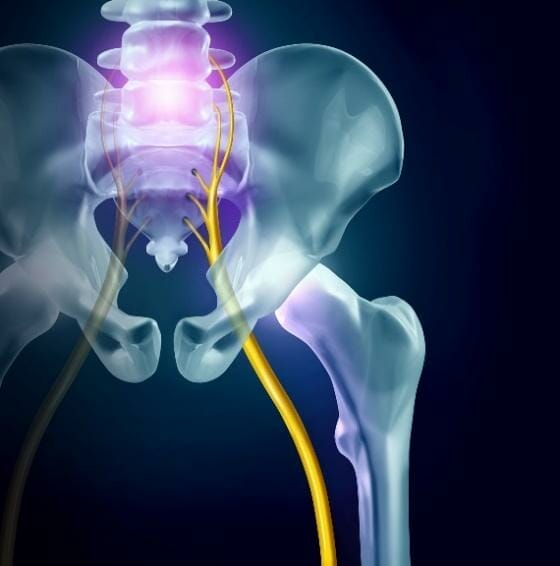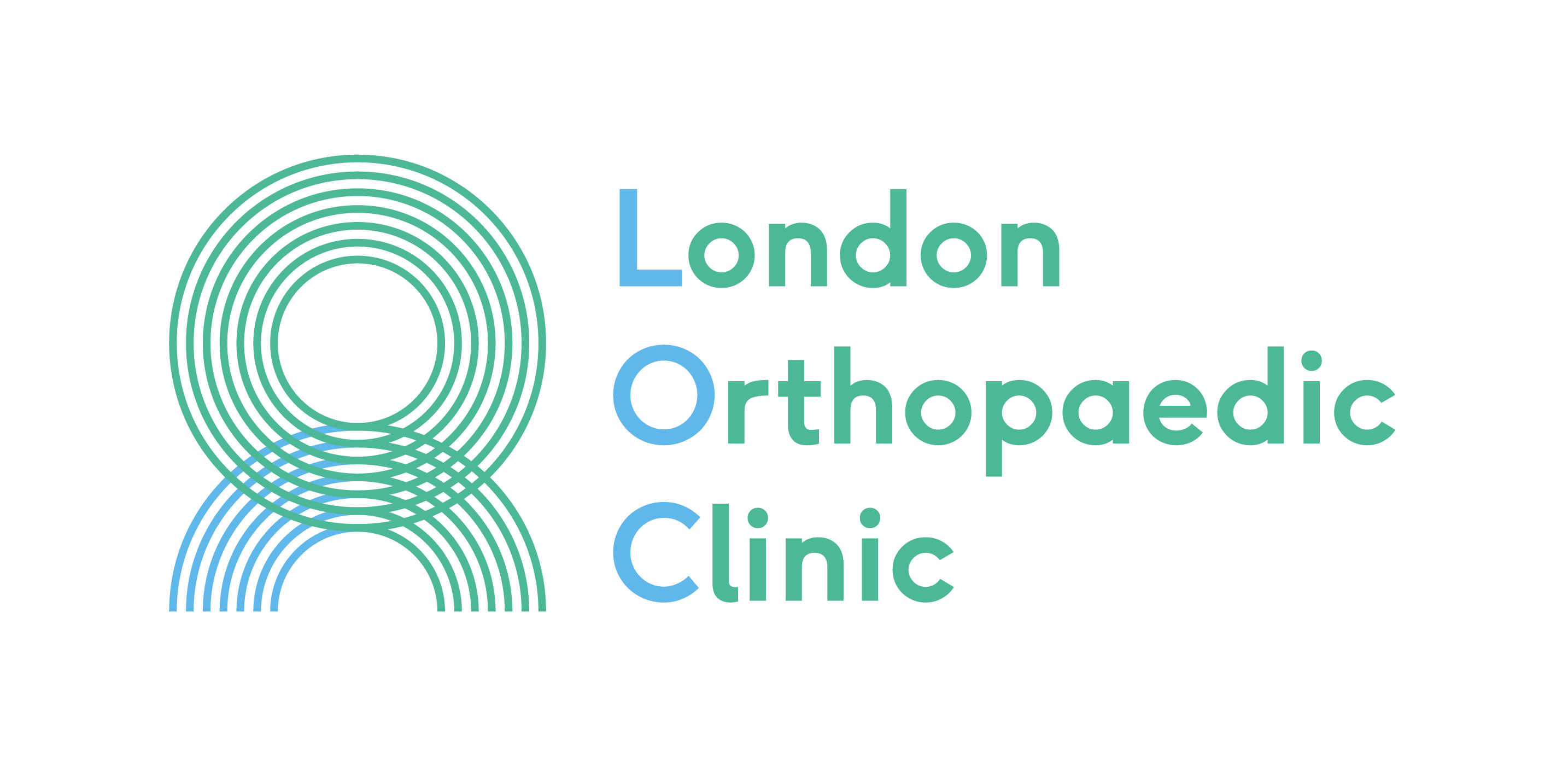Sciatica
What is sciatica?
Sciatica is a term used to describe any kind of pain caused by irritation or compression of the sciatic nerve.
The sciatic nerve is comprised of several nerves that branch out from each side of the lower spine. These nerves merge together to form the sciatic nerve, which runs through the hip, buttock, and thigh, and down the leg to the foot.
The most common cause of sciatica is a herniated (“slipped”) lumbar disc pressing against the sciatic nerve root.
Other causes of sciatic nerve pain include:
- Piriformis syndrome – spasm of the piriformis muscle in the buttock that can irritate the nearby sciatic nerve.
- Degenerative disc disease – breakdown of the shock-absorbing discs between the spinal bones (vertebrae) that often occurs as the body ages; in combination with arthritis of the facet joints, this may cause narrowing of the small exit canals in the spine.
- Spondylolisthesis – when one vertebra slips forwards or backwards over an adjacent one, usually due to a stress fracture in the joint; this can lead to irritation of the sciatic nerve roots.
- Lumbar spinal stenosis – narrowing of the spinal canal (the hollow space within the spine) due to osteoarthritis or other conditions.
- Bone spurs – smooth overgrowths of bone that form on the vertebrae in the lower back.
- Pregnancy – due to the enlarged uterus putting pressure on the sciatic nerve.
- Spinal tumour (rare).
Signs and symptoms of sciatica
The hallmark of sciatica is pain that radiates through the buttock and back of one leg. It is often described as a shooting pain, although some patients report numbness or a tingling/burning sensation along the nerve path in the leg.
Sciatic nerve pain can range from mild to severe in intensity and may be intermittent or continuous. Although weakness is not often reported, this is an indication that the condition is more serious. Patients may have difficulty standing up, and symptoms are often made worse with sitting or coughing/sneezing. Pain in the lower back may also be present, although this is usually not as severe as the leg pain.
Sciatica usually only affects one side of the body, but if pain is experienced on both sides, this can indicate a more serious health problem known as cauda equina syndrome. This condition can also lead to loss of bowel or bladder function and/or progressive weakness in the legs. Medical help should be sought immediately if any of these symptoms are experienced.

Signs and symptoms of sciatica
The hallmark of sciatica is pain that radiates through the buttock and back of one leg. It is often described as a shooting pain, although some patients report numbness or a tingling/burning sensation along the nerve path in the leg.
Sciatic nerve pain can range from mild to severe in intensity and may be intermittent or continuous. Although weakness is not often reported, this is an indication that the condition is more serious. Patients may have difficulty standing up, and symptoms are often made worse with sitting or coughing/sneezing. Pain in the lower back may also be present, although this is usually not as severe as the leg pain.
Sciatica usually only affects one side of the body, but if pain is experienced on both sides, this can indicate a more serious health problem known as cauda equina syndrome. This condition can also lead to loss of bowel or bladder function and/or progressive weakness in the legs. Medical help should be sought immediately if any of these symptoms are experienced.
How is sciatica diagnosed?
During your initial assessment at The London Orthopaedic Clinic (TLOC), the doctor will take a medical history and perform a physical examination. If sciatica is suspected, he/she will perform neural tension tests which may include a Straight Leg Raise test; this stretches the sciatic nerve and checks for the source of the pain. Your reflexes may be tested alongside testing for motor power and sensation in your legs.
Your doctor may refer you for further diagnostic tests, which most commonly include an MRI (magnetic resonance imaging) of your lumbar spine and/or pelvis. Occasionally, X-rays or CT scans may be used in addition to nerve conduction tests to help confirm the diagnosis.
What sort of treatment can I expect?
Most people with sciatica do not require surgery. Treatment focuses on relieving the pain and keeping patients as active as possible. If your sciatica is particularly severe, lying down for short periods can help, although prolonged bed rest is generally not advised.
Your doctor will usually recommend using anti-inflammatory medication at first and then prescribe stronger pain relievers if needed. A muscle relaxant may be prescribed for muscle spasms and anti-neuropathic drugs may be added to reduce nerve-related pain. In some cases, spinal injections of anti-inflammatory steroids are used to reduce pain and inflammation around the spinal nerve. Your doctor may also suggest exercises and stretches to do at home. Other self-care measures such as applying heat or ice packs can be effective, especially when the pain initially occurs.
Physical therapy can be an effective treatment strategy for sciatica. It can help to reduce pain and prevent future flare-ups by strengthening the core and back muscles and improving flexibility. Alternative approaches such as massage, acupuncture, and chiropractic manipulation are sometimes helpful.
For patients with severe or persistent sciatica that doesn’t improve over time, surgery may be recommended to correct an underlying problem. For example, in patients with disc herniation, a discectomy may be performed to remove the part of the disc that is pressing on the sciatic nerve. On the other hand, patients with lumbar spinal stenosis may require a lumbar laminectomy; with this procedure a portion of the bone (lamina) on the spine is removed, relieving the pressure on the spinal nerves.
What happens if I don’t get treatment for sciatica?
As sciatica is often caused by an underlying spinal condition, it is important not to ignore it. If you don’t seek help from a medical professional, the problem may continue to worsen over time, potentially causing lasting damage to the lower back and loss of mobility.
Services at TLOC

TLOC is committed to providing the highest quality of care throughout the patient journey. We offer a full range of services, from initial assessment and diagnosis, to individualised treatment and rehabilitation plans.
Our multidisciplinary team of experts can advise you on the best course of treatment for your sciatica and help ease your pain. TLOC will arrange all your bookings for scans and other medical investigations, leaving you more time to focus on your recovery. All diagnostic services and physical therapies are performed in-house or at our partner institutions nearby.
Sciatica can cause significant pain and discomfort for the sufferer, but a variety of treatment options are available. Most people don’t require surgery and get better after approximately 6 weeks. In case of persistent sciatic nerve pain, it is important to treat the underlying cause to avoid worsening of the condition.
Please note that the information provided above is intended as a general guide only. If you are concerned about your health or recovery, please contact TLOC for further assistance and advice.
